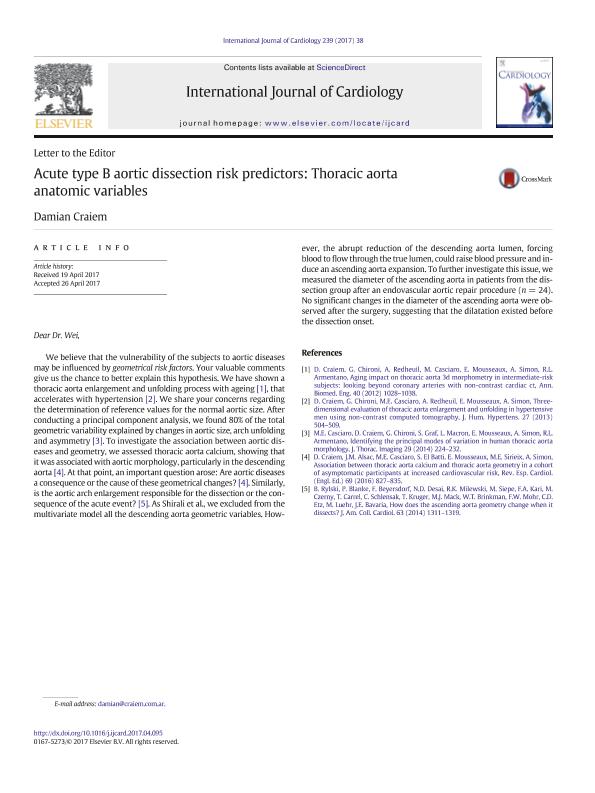Artículo
Acute type B aortic dissection risk predictors: Thoracic aorta anatomic variables
Fecha de publicación:
07/2017
Editorial:
Elsevier Science
Revista:
International Journal of Cardiology
ISSN:
0167-5273
Idioma:
Inglés
Tipo de recurso:
Artículo publicado
Clasificación temática:
Resumen
We believe that the vulnerability of the subjects to aortic diseases may be influenced by geometrical risk factors. Your valuable comments give us the chance to better explain this hypothesis. We have shown a thoracic aorta enlargement and unfolding process with ageing [1], that accelerates with hypertension [2]. We share your concerns regarding the determination of reference values for the normal aortic size. After conducting a principal component analysis, we found 80% of the total geometric variability explained by changes in aortic size, arch unfolding and asymmetry [3]. To investigate the association between aortic diseases and geometry, we assessed thoracic aorta calcium, showing that it was associated with aortic morphology, particularly in the descending aorta [4]. At that point, an important question arose: Are aortic diseases a consequence or the cause of these geometrical changes? [4]. Similarly, is the aortic arch enlargement responsible for the dissection or the consequence of the acute event? [5]. As Shirali et al., we excluded from the multivariate model all the descending aorta geometric variables. However, the abrupt reduction of the descending aorta lumen, forcing blood to flow through the true lumen, could raise blood pressure and induce an ascending aorta expansion. To further investigate this issue, we measured the diameter of the ascending aorta in patients from the dissection group after an endovascular aortic repair procedure (n = 24). No significant changes in the diameter of the ascending aorta were observed after the surgery, suggesting that the dilatation existed before the dissection onset.
Palabras clave:
Aortic Dissection
,
Geometrical Variables
,
Risk Prediction
Archivos asociados
Licencia
Identificadores
Colecciones
Articulos(OCA HOUSSAY)
Articulos de OFICINA DE COORDINACION ADMINISTRATIVA HOUSSAY
Articulos de OFICINA DE COORDINACION ADMINISTRATIVA HOUSSAY
Citación
Craiem, Damian; Acute type B aortic dissection risk predictors: Thoracic aorta anatomic variables; Elsevier Science; International Journal of Cardiology; 239; 7-2017; 38-38
Compartir
Altmétricas




